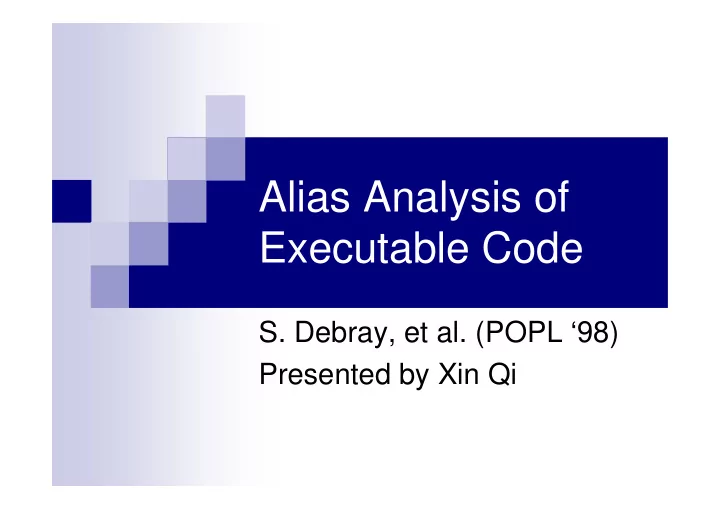

Alias Analysis of Executable Code S. Debray, et al. (POPL ‘98) Presented by Xin Qi
What is Special about Executables � We no longer have � Types – can’t do type filtering � Structures – jump all around � We have � Pointer arithmetics – a lot! � Normally whole-program information � In addition � Compilers can do something unexpected � Tom Reps’ example about uninitialized variables
Introduction to the Analysis � Works on RISC instruction set � Memory accessed only through load & store � Three-operator integer instructions: � Basically only add & mult (sub & mov modeled by add) � Bitwise operators? � Properties of the analysis � May alias analysis � Flow-sensitive, context-insensitive, interprocedural
Naïve Approach � Local Alias Analysis � Within a basic block � Two references are not aliasing each other if � Either they use distinct offsets from the same base register, and the register is not redefined in between � Or one points to stack and the other points to global data area � Not working across basic block boundaries
Residue-based Approach � Want to know the set of possible addresses referenced by a memory access � Basically the set of possible values in a register � Impractical to consider all possible integer values in registers � For instruction add & mult, a very natural thing is to consider mod-k residues � Very easy to compute the new residue � k = 2 m – The set of {0, 1, …, k – 1} is called Z k
Residue-based Approach (cntd) � Not always possible to compute a set of actual values for a register � User inputs � Read from memory � Can’t just say that it is Z k � Too imprecise
Example load r1, addr … add r1, 3, r2 add r1, 5, r3 …
Address Descriptors � The idea of “being relative to a common value” is captured in address descriptors � Address descriptors < I , M > � I – defining instruction, abstract away the unknown part � M – residue set, as before
Address Descriptors (cntd) � Defining instruction I � Can be an instruction, NONE, or ANY � <NONE, *> represents absolute addresses � <ANY, *> is essentially ⊥ � Residue set M � Set of mod-k addresses relative to the value defined in the instruction � <*, Z k > is also ⊥
Address Descriptors (cntd 2 ) � val P ( I ) = set of values that some execution path of P would make I evaluate to � Concretization function � conc P (< I , M >) = { w + ik + x | w ∈ val P ( I ), x ∈ M , i ≥ 0} � Why should i ≥ 0?
Address Descriptors (cntd 3 ) � A preorder relation < I 1 , M 1 > · < I 2 , M 2 > � I 1 = ANY or M 1 = Z k � M 2 = ∅ � I 1 = I 2 and M 1 ⊆ M 2 � An equivalence relation � <*, Z k > = <ANY, *> = ⊥ � <*, ∅ > = > � We hence have a lattice
The Algorithm � Transfer function � Load r, addr � <NONE, { val mod k }> if addr is read-only with val � < I , {0}> � Add src a , src b , dest (< I a , M a > and < I b , M b >) � If one of I a and I b is NONE, say I a � A ’ = < I b , {( x a + x b ) mod k | x a ∈ M a , x b ∈ M b }> � A ’ if A ’ ≠ ⊥ ; < I , {0}> otherwise � Otherwise, < I , {0}>
The Algorithm (cntd) � For each program point, only keep a single address descriptor for each register � Take glb if there are more � Reasoning alias relationships � For different I ’s. can’t say much but assume may alias � For same I , need to check it is the same value computed by I
Experimental Results � Benchmarks � SPEC-95, and 6 others � k = 64 � Precision measurement � Number of memory references that some information is obtained � 30% ~ 60% � Cost � Time and space: almost linear
Experimental Results (cntd) � Reason for loss of precision & for low cost � Memory is not modeled � No information for something that is saved in memory, and read out later � Multiple address descriptors are merged for every program point � Context insensitivity
Experimental Results (cntd 2 ) � Utility of the analysis � Reducing the number of load instructions � Naïve algorithm improves by almost always · 1% � This algorithm improves often close to 2%, sometimes even higher � Not very impressive still � Because … � Compiler has done a good job � Not many free registers to use
Conclusion � It is an interesting problem to analyze executable code � The algorithm is � Simple and elegant � Scalable � Somewhat useful
� Possible improvements? Discussion � Weakness?
Recommend
More recommend